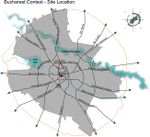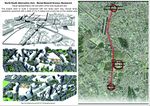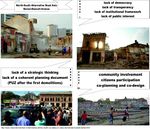Landscape Democracy 2015 Working Group E - Case Study 2: Difference between revisions
| (17 intermediate revisions by 2 users not shown) | |||
| Line 1: | Line 1: | ||
---> back to group page [[Landscape_Democracy_2015_-_Working_Group_E|working group E]] | ---> back to group page [[Landscape_Democracy_2015_-_Working_Group_E|working group E]] | ||
''''' | '''''North-South Road Axis Alternative for Bucharest - Landscape Democracy vs non-democracy''''' | ||
{| align="right" width="300pt" style="background:Gainsboro; color:black" | {| align="right" width="300pt" style="background:Gainsboro; color:black" | ||
|- | |- | ||
| '''Place name''' ||style="background:Lavender"| '' | | '''Place name''' ||style="background:Lavender"| '' Berzei-Buzesti-Uranus Alternative Road Axis'' | ||
|- | |- | ||
| '''Location''' || style="background:Lavender"|'' | | '''Location''' || style="background:Lavender"|''Bucharest'' | ||
|- | |- | ||
| '''Country''' || style="background:Lavender"|'' | | '''Country''' || style="background:Lavender"|''Romania'' | ||
|- | |- | ||
| '''Author(s)''' || style="background:Lavender"|'' | | '''Author(s)''' || style="background:Lavender"|''Miruna Draghia'' | ||
|- | |- | ||
| colspan="3" align="center" style="background:silver"| [[ | | colspan="3" align="center" style="background:silver"|[[File:Site location.jpg|300px]] | ||
|- | |- | ||
|- | |- | ||
| colspan="3" align="center" style="background:silver"| {{#widget:GoogleMaps | | colspan="3" align="center" style="background:silver"| {{#widget:GoogleMaps | ||
|width=300 | |width=300 | ||
|height=200 | |height=200 | ||
|lat= | |lat=44.439663 | ||
|lng=- | |lng=-26.096306 | ||
|zoom= | |zoom=11 | ||
|centermarker=yes | |centermarker=yes | ||
|maptypecontrol=yes | |maptypecontrol=yes | ||
| Line 33: | Line 32: | ||
== Rationale: Why have you chosen this case for the landscape and democracy seminar? == | == Rationale: Why have you chosen this case for the landscape and democracy seminar? == | ||
I have chosen a very debated and well-known case from Bucharest,North-South Axis - Berzei-Buzesti, because it is an example of both good and bad democracy over an urban landscape. This project was divided into three stages, the only finalised one being the first - which is the bad side of the landscape democracy and governance, while the second is in the final stage of approval. The third one is still pending, because of the community involvement and pressure over the public authorites. I have also chosen this controversial case study because it is about a public intervention, on one side, with a social character and collective/ public interest, on the other hand, an intevention with historical and cultural character, aimed at restructuring a historic urban tissue from the central area of the city. | |||
== Representation of your observations == | == Representation of your observations == | ||
| Line 40: | Line 39: | ||
The main problems regarding landscape and democracy for this intervention were the public authorities' communication incapacity and the lack of transperancy in the planning process. Besides the public authorities lack of interest in public participation, co-design, placemaking, Romanian law and institutional framework are also inadequate for citizens real needs of these times. | The main problems regarding landscape and democracy for this intervention were the public authorities' communication incapacity and the lack of transperancy in the planning process. Besides the public authorities lack of interest in public participation, co-design, placemaking, Romanian law and institutional framework are also inadequate for citizens real needs of these times. | ||
<gallery caption=" | <gallery caption="Observations" widths="150px" heights="150px" perrow="4"> | ||
Image: | Image:Site location.jpg|case representation | ||
Image: | Image:3D visualisation.jpg|case representation | ||
Image: | Image:Berzei Photos.jpg|case representation | ||
Image: | Image:Images 2.jpg|case representation | ||
</gallery> | </gallery> | ||
== Reflection == | == Reflection == | ||
=== What are the major challenges for changing the situation? === | === What are the major challenges for changing the situation? === | ||
First of all, we are talking about city governance and the removal of the lack of transperancy. One of the most problematic situations in Romania's town and landscape planning is the lack of an unitary and coherent institutional and legal framework. The second one, is the public authorities lack of interest in public participation and placemaking processes. All these challenges should be considered in the climate of a post-comunist country, where the changes are more necessary in order to complete the transition from a centralised and controlled planning to a more flexible, adaptable and participatory one. The key aspects of these challenges are even more obvious considering the level of bureaucracy, stakeholders conflicts, the lack of national and local funding and public authorities inflexibility and sometimes, even incapacity. | |||
=== What could be a starting point for democractically-based change? === | === What could be a starting point for democractically-based change? === | ||
Recently, there has been started a trend in public participation (one pilot-project being YPLAN - Young Placemakers Initiative, which aims to raise awareness and understanding of the potential of the urban spaces and landscapes, encouraging active involvement of a group of high school students). Personally, I think that this kind of initiatives could be a great starting point for a democratically-based change which could happen on every level of governance, promoting both top-down and bottom-up approaches to urban and landscape planning. In order to achieve fundamental changes in the planning processes, there should be a significant gap reduction between the level of citizen involvent in Romania and the other develop countries in Europe. Planning processes should be based on a jointly controlled strategy with an equal implication of government (national and local authorities) and community, raising the current social empowerment being fundamental in creating high-quality landscapes and places. | |||
== Stakeholder Mapping == | |||
''Create a visual representation of the stakeholder groups that are involved in your case. Try to cover the following aspects in your representation: Power (high, medium, low) / Support (positive, neutral, negative)/ Influence (high or low)/ Need (strong, medium, weak)+ also map the relationships between the stakeholder groups'' | |||
<gallery caption="Stakeholder Map" widths="600px" heights="300px" perrow="1"> | |||
File:mystakeholermap.JPG|Stakeholder Map | |||
</gallery> | |||
== Change Scenario == | |||
''Look at the various methods and tools available and think how they can be applied creatively. Think about the needs of different stakeholder groups - you may need a methodical mix to address them all. Visualize a scenario illustrating how these methods/tools can be applied within an imagined time frame '' | |||
<gallery caption="Change Scenario" widths="600px" heights="300px" perrow="1"> | |||
File:mychange szenario.JPG|Change Scenario | |||
</gallery> | |||
== Cross cutting theme == | |||
Identify a cross-cutting theme/topic between the cases of your group and write a short reflection on it (approx. 150 words) | |||
== Concluding reflections == | |||
Reflect on your case and your change model. Potentials? Limitations? (approx. 150 words) | |||
== References == | == References == | ||
http://reteaualiterara.ning.com/profiles/blogs/salvati-piata-matache | *http://reteaualiterara.ning.com/profiles/blogs/salvati-piata-matache | ||
http://www.activewatch.ro/Assets/Upload/files/Viziune-alternativa-Platforma_pt-primarie-si-CTUAT.pdf | *http://www.activewatch.ro/Assets/Upload/files/Viziune-alternativa-Platforma_pt-primarie-si-CTUAT.pdf | ||
http://issuu.com/zeppelin.magazine/docs/dosarul_buzesti-uranus | *http://issuu.com/zeppelin.magazine/docs/dosarul_buzesti-uranus | ||
http://sorinoprescu.ro/proiecte/diametrala-buzesti-berzei-uranus | *http://sorinoprescu.ro/proiecte/diametrala-buzesti-berzei-uranus | ||
http://www.observatorulurban.ro/prezentarea-axei-buzeti-uranus-la-uauim-iii.html | *http://www.observatorulurban.ro/prezentarea-axei-buzeti-uranus-la-uauim-iii.html | ||
http://www.rfi.ro/social-68732-galerie-foto-axa-buze-ti-berzei-uranus-mai-face-o-victim-vezi-ce-spune-nicu-or-dan | *http://www.rfi.ro/social-68732-galerie-foto-axa-buze-ti-berzei-uranus-mai-face-o-victim-vezi-ce-spune-nicu-or-dan | ||
http://arhitectura-1906.ro/2011/12/dosar-comentat-buzesti-berzei-uranus-invitat-constantin-enache/ | *http://arhitectura-1906.ro/2011/12/dosar-comentat-buzesti-berzei-uranus-invitat-constantin-enache/ | ||
Latest revision as of 12:55, 9 December 2015
---> back to group page working group E
North-South Road Axis Alternative for Bucharest - Landscape Democracy vs non-democracy
| Place name | Berzei-Buzesti-Uranus Alternative Road Axis | |
| Location | Bucharest | |
| Country | Romania | |
| Author(s) | Miruna Draghia | |

| ||
|
| ||
Rationale: Why have you chosen this case for the landscape and democracy seminar?
I have chosen a very debated and well-known case from Bucharest,North-South Axis - Berzei-Buzesti, because it is an example of both good and bad democracy over an urban landscape. This project was divided into three stages, the only finalised one being the first - which is the bad side of the landscape democracy and governance, while the second is in the final stage of approval. The third one is still pending, because of the community involvement and pressure over the public authorites. I have also chosen this controversial case study because it is about a public intervention, on one side, with a social character and collective/ public interest, on the other hand, an intevention with historical and cultural character, aimed at restructuring a historic urban tissue from the central area of the city.
Representation of your observations
The aim of this project is to relieve and redistribute the traffic from the center area of Bucharest, facilitating the connection between principal landmarks of the city: North Railway Station, Victory Square (the government location), historical centre, Izvor Sqaure (the Parliament House) and the south part of the city. The project of building this new axis (Buzesti-Uranus) is considered one of the most courageous and highly important urban intervention in the last 20 years in Bucharest regarding the road infrastructure in the central area and the replacement of an urban tissue. Without any public debate or even a town planning document (PUZ - zonal urbanistic plan), public authorities started expropriation and demolition processes in the necessary area for building the new boulevard. Because we are talking about the central and historical area of the city, in this processes were involved a consistent number of protected and historical buildings. One of the most famous and well-known building which has been demolished was Matache The Butcher Hall. After a lot of pressure from the NGO's, public authorities started to design a planning document (PUZ), whose aim was to remedy the mismanagement of the initial phase of the project. The main problems regarding landscape and democracy for this intervention were the public authorities' communication incapacity and the lack of transperancy in the planning process. Besides the public authorities lack of interest in public participation, co-design, placemaking, Romanian law and institutional framework are also inadequate for citizens real needs of these times.
- Observations
Reflection
What are the major challenges for changing the situation?
First of all, we are talking about city governance and the removal of the lack of transperancy. One of the most problematic situations in Romania's town and landscape planning is the lack of an unitary and coherent institutional and legal framework. The second one, is the public authorities lack of interest in public participation and placemaking processes. All these challenges should be considered in the climate of a post-comunist country, where the changes are more necessary in order to complete the transition from a centralised and controlled planning to a more flexible, adaptable and participatory one. The key aspects of these challenges are even more obvious considering the level of bureaucracy, stakeholders conflicts, the lack of national and local funding and public authorities inflexibility and sometimes, even incapacity.
What could be a starting point for democractically-based change?
Recently, there has been started a trend in public participation (one pilot-project being YPLAN - Young Placemakers Initiative, which aims to raise awareness and understanding of the potential of the urban spaces and landscapes, encouraging active involvement of a group of high school students). Personally, I think that this kind of initiatives could be a great starting point for a democratically-based change which could happen on every level of governance, promoting both top-down and bottom-up approaches to urban and landscape planning. In order to achieve fundamental changes in the planning processes, there should be a significant gap reduction between the level of citizen involvent in Romania and the other develop countries in Europe. Planning processes should be based on a jointly controlled strategy with an equal implication of government (national and local authorities) and community, raising the current social empowerment being fundamental in creating high-quality landscapes and places.
Stakeholder Mapping
Create a visual representation of the stakeholder groups that are involved in your case. Try to cover the following aspects in your representation: Power (high, medium, low) / Support (positive, neutral, negative)/ Influence (high or low)/ Need (strong, medium, weak)+ also map the relationships between the stakeholder groups
- Stakeholder Map
- Mystakeholermap.JPG
Stakeholder Map
Change Scenario
Look at the various methods and tools available and think how they can be applied creatively. Think about the needs of different stakeholder groups - you may need a methodical mix to address them all. Visualize a scenario illustrating how these methods/tools can be applied within an imagined time frame
- Change Scenario
- Mychange szenario.JPG
Change Scenario
Cross cutting theme
Identify a cross-cutting theme/topic between the cases of your group and write a short reflection on it (approx. 150 words)
Concluding reflections
Reflect on your case and your change model. Potentials? Limitations? (approx. 150 words)
References
- http://reteaualiterara.ning.com/profiles/blogs/salvati-piata-matache
- http://www.activewatch.ro/Assets/Upload/files/Viziune-alternativa-Platforma_pt-primarie-si-CTUAT.pdf
- http://issuu.com/zeppelin.magazine/docs/dosarul_buzesti-uranus
- http://sorinoprescu.ro/proiecte/diametrala-buzesti-berzei-uranus
- http://www.observatorulurban.ro/prezentarea-axei-buzeti-uranus-la-uauim-iii.html
- http://www.rfi.ro/social-68732-galerie-foto-axa-buze-ti-berzei-uranus-mai-face-o-victim-vezi-ce-spune-nicu-or-dan
- http://arhitectura-1906.ro/2011/12/dosar-comentat-buzesti-berzei-uranus-invitat-constantin-enache/



